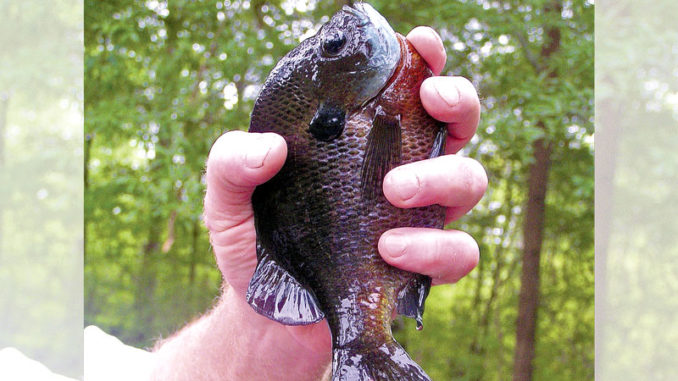
Doing battle with Louisiana’s sunfish is limited only by an angler’s imagination. Check out these different ways that a West Monroe botanist puts them on his stringer.
Fishing for bream isn’t child’s play.
“I know that bream were the first fish we caught when we were children, but it doesn’t make it any less fun for an adult,” said Ray Jones, a retired botany professor from West Monroe who also has earned the nickname “Dr. Bream.”
“Bream fishing is easy. Bream catching isn’t always as easy, unless you are prepared with equipment for several different ways of fishing,” he said. “The amount of gear you have probably should relate to how serious you are about bream fishing. Bream follow patterns just like other fish.”
The “patterns” Jones is referring to are that bream — especially big bream — don’t always stay in the same place, at the same depth. Usually, when the weather is warm, you can catch bream in shallow water, but where they’re located may vary. Sometimes when they are on their beds, they are in open spaces with a clean bottom. At other times, they are close to trees, stumps or brushtops. And still other times, they move a little bit deeper and hang out on the bottom.
The good news is that you don’t have to spend a fortune to buy bream equipment. One rod will do, but having some different tools can also help you catch them more consistently.
Most bream fishermen started out with a cane pole, a bobber and a cricket. That still works, but there are a whole lot of other choices. Some are personal preference, but others give anglers a chance to catch bluegills, sunperch and chinquapins on a more consistent basis.
And you can even come up with your own outfit if you are creative and still love to catch bream — no matter how old you are.
Love of the sport
“I don’t mind saying it one bit,” Jones said. “I still love to go bream fishing when I get the chance.”
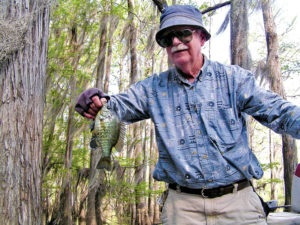
His love for bream or any kind of panfish in heavy cover led Jones to develop an outfit that you won’t find in any tackle store, but it’s one on the list of possibilities.
Jones took a simple crappie reel, made years ago by the Miles Bait Company in Winnsboro, and attached it to an inexpensive, hollow, fiberglass rod. He carefully drilled a small hole about two inches above the reel, sanded it down to protect the line and then threaded his fishing line on the inside of the pole all the way to the tip. He controls depth by letting line off the reel, and the rig allows him to stick the pole up in heavy brush or under tree limbs without having to worry about the line between the guides getting hung in the brush or limbs.
If you don’t want to design your own outfit like Jones did, there are plenty of choices. Bream fishermen don’t have to use a different outfit for every type of lure or presentation like bass fishermen might, but it doesn’t hurt to have some options.
Here are some of the combos that are popular among the state’s dedicated perch jerkers:
Cane pole
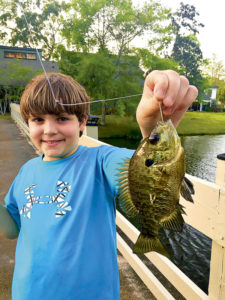
No, they aren’t extinct. You can buy them at most sporting goods stores, especially ones that sell live bait. It is the least expensive way to fish and lets you fish with just about any kind of live bait, from crickets to worms and grub worms.
You can buy and rig out a cane pole for less than $5.
Jig pole
These commercially produced “cane poles” are a little more sturdy than their natural companion, but they also allow a little more feel and control. Many of them also collapse, which makes transportation and storage easier. They can be fished much the same as a cane pole with a float to adjust depth, but they can also be fished effectively with only a weight and hook by “tight-lining” to vary depths easily while fishing.
A lot of bream fishermen also like to feel the bite, much like their crappie fishing friends enjoy feeling “the thump.”
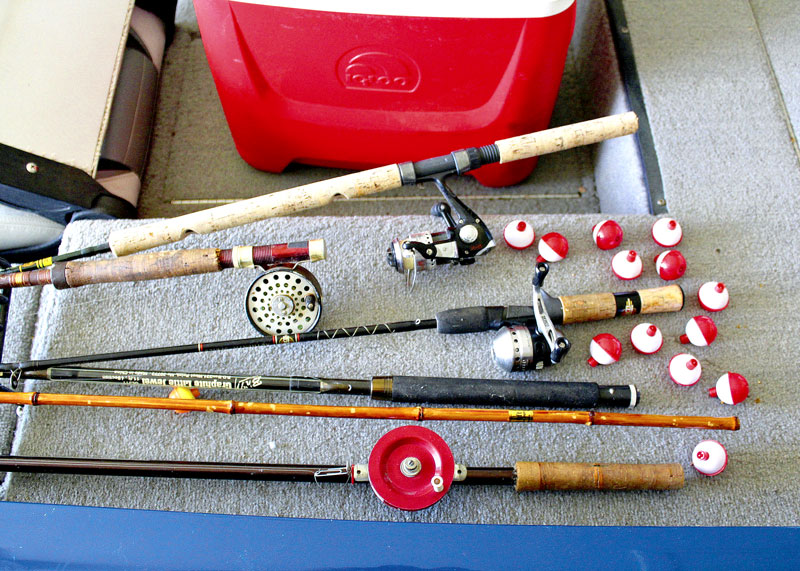
Fly rod
Fly rods aren’t just for trout fishermen. The use of a small popper with flexible legs and a bright-colored body is a long-standing tradition among bream fishermen. In open areas, you can work the line and rod in harmony to lay your bait right by the edge of an old log or alongside the edge of a weed bed.
Most-effective flies for bream are the floating baits that resemble a bug or spider. The best way to work the popping bug is to cast it out and let it sit a second. Most times, if a bream is nearby, he’ll suck it in before the ripples disappear. If they don’t, simply “pop” it a few times and work it back toward you until it is away from the area the bream are hanging out in.
Spinning tackle
Open-faced spinning rigs that start with light rods allow anglers several options. You can fish it with a cork like a pole, or you can flip your bait out 10 to 20 feet from the boat or bank. You can also use this rig to fish as deep or as shallow as you want.
Some fishermen use the same outfits for bream that they do for crappie.
Spin-Cast tackle
Spin-casting reels are easy to use and provide the same benefits as the open-faced spinning gear. The biggest difference is the ability for anybody to fish with it by simply pushing the button and casting the bait out.
These rigs are especially effective for fishing small spinners or Beetle Spin-type lures where you can cast out past where the fish are hiding and slowly retrieve it back to the boat. You can cover a lot of good bream water with one of these combos.
D-I-Y outfit
We’ve already covered what Jones did with his homemade rod-and-reel combo. You can combine just about any element you want from the wide assortment of tackle available and still keep the cost reasonable. Pick and rod and reel that you like, modify it to fit your needs and go fishing.
Summary
No matter what type of fishing outfit you decide to use to catch bream, summer is the time to do it. Fish are more active this time of year, and in most lakes, they will bed at least twice. When you find a big bed of bream, you can catch 20, 30 or 40 or more in one spot. If you get on a bed and the action slows, don’t leave, just give them about 10 minutes to regroup and try again. You might be surprised how many you catch right back out of the same spot.
A little bream fishing humor
My oldest granddaughter learned to fish at a young age, and she learned not to be afraid of sticking her hand in a cricket box. She could bait her own hook by the time she was four and loves catching fish almost as much as I do.
One day, we were down on the pier and she was playing with the cricket box. I noticed her throw something out in the water and walked over. She was catching crickets and tossing them out in the water, one at a time. Some of them were still swimming, but most of them were disappearing in a big, old swirl of bream.
“What are you doing?” I asked.
“Just fishing, Poppa,” she said. “And look, they’re biting.”
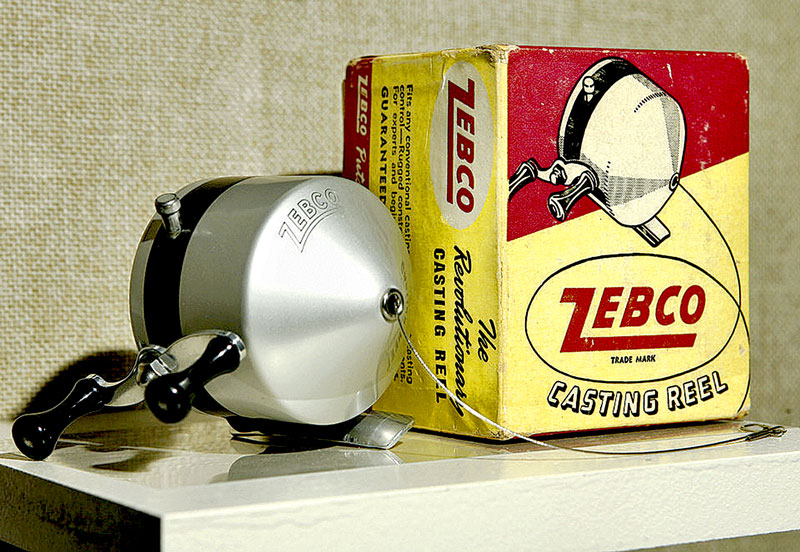
The Lashmaster
It was — and still is — the “bomb!”
It began as a vision of watchmaker R.D. Hull in a Roten, Texas, grocery store in the late 1940s, then, moved into production at the Zero Hour Bomb Company in Tulsa, Okla., and soon after it’s release in 1953, it became an overnight sensation.
The Zebco 33, originally named “The Lashmaster,” became the first reel that would cast easily and not backlash. It was used for all kinds of fish at first, but by the 1960s, became a staple of almost every bream fisherman who didn’t use a cane pole.
And of course, the Zero Hour Bomb Company became ZEBCO. That was for a lot of reasons, like when a package of reels was sent to President Dwight D. Eisenhower in 1956 with the company’s name in the return address; it was even submerged in water by White House security.
Today, it’s still “the bomb” — modern-day slang for “something really cool.” It is made for 10-pound line but easily handles 6-pound for anglers who like a smaller presentation for finicky bream. It also pairs nicely with an inexpensive, light-action, 4- to 6-foot fiberglass or graphite rod for bream.
More than 40 million have been sold, and many have been submerged in water as well. There is no way to even guess how many bream that little reel — which started out as a prototype made with nails, a bolt and a Folger’s Coffee can lid — has out in the boat.


